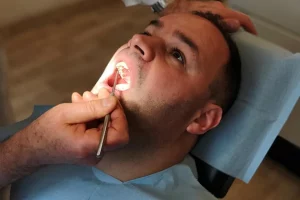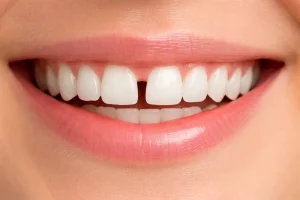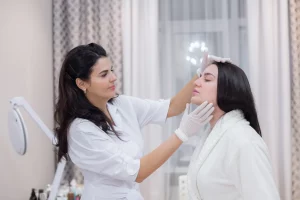Straightening teeth isn’t just about vanity. It’s about function, bite health, and keeping your mouth in good working order. The problem? You’ve got options, and the internet has opinions. At Oris Dental Center in Dubai, we see patients stuck on one question more than any other: Should I go with Invisalign or braces?
The answer is that both work. But they’re different tools for different jobs. Let’s take a clear-eyed look at what each does, where they excel, what might suit you best and also what is best in Dubai for you with the costs of Invisalign and braces in Dubai.
Traditional Braces
They’ve been around for decades, but modern braces are slimmer, smoother, and far less medieval than the ones you might remember from school photos.
- What they are: Small metal brackets cemented to each tooth, connected by arch wires. Elastic bands sometimes hold the wire in place.
- How they work: Consistent pressure moves teeth gradually into their target positions.
- When they shine: Severe crowding, big bite problems, rotated teeth, or just about any complex orthodontic case you can throw at them.
Invisalign
Invisalign took a simple idea, removable almost invisible trays, and paired it with precise 3D imaging. The result is a treatment that fits into daily life without broadcasting it.
- What they are: Custom-made, clear plastic aligners that fit snugly over your teeth.
- How they work: Each aligner moves teeth a little further. You swap them every 1–2 weeks until the job’s done.
- When they shine: Mild to moderate crowding, small gaps, and bite corrections where removable trays can do the heavy lifting.
Side-by-Side Comparisons That Actually Matter
Looks
Invisalign: Virtually invisible unless someone’s inspecting your teeth at close range.
Braces: Always visible, though ceramic or lingual versions can reduce the glare.
If you give presentations, attend events, or just don’t want the “metal mouth” look, Invisalign has the obvious advantage.
Comfort
Invisalign: Smooth edges, no wires to catch your cheeks. Adjustments feel more like mild pressure than a full jaw workout.
Braces: Brackets and wires can rub or poke until you toughen up. Adjustments tighten things, which can mean soreness for a day or two.
Eating and Drinking
Invisalign: Take them out, eat what you like, put them back in after brushing.
Braces: No hard, sticky, or chewy foods unless you enjoy emergency wire repairs.
Cleaning
Invisalign: Brush and floss normally, clean the trays to avoid staining or odor.
Braces: You’ll need to work around brackets and wires. Water flossers help, but it’s still more effort. Poor cleaning risks white spots or decay.
Duration
Invisalign: Often 12–18 months for straightforward cases, sometimes as short as six. Complex cases can stretch longer.
Braces: Usually 18–36 months, though for severe issues they can be faster than aligners.
Discipline vs. Dependence
Invisalign: Removable, which is great if you wear them. Less than 20–22 hours of daily wear slows progress.
Braces: Fixed. You can’t “forget” them, which is useful for teenagers and the forgetful.
Suitability and Case Complexity
Invisalign: Great for mild and moderate misalignment, gaps, and bite tweaks. Not ideal for teeth that need big rotations, major jaw adjustments, or multiple complex corrections at once.
Braces: Handle the easy stuff and the nightmare cases equally well. They don’t rely on your compliance.
Some patients start with braces for the heavy lifting, then switch to Invisalign for refinement.
Technology Has Changed the Game
Invisalign’s edge
- Digital scans replace sticky impression trays
- SmartTrack material gives predictable movement
- Attachments (small tooth-colored bumps) increase control
- Replacement trays can be made if one’s lost
Braces’ edge
- Self-ligating brackets reduce friction and may speed treatment
- Ceramic and lingual options improve aesthetics
- Still unbeatable for complex mechanics that aligners can’t match
The Money Question
Dubai averages
- Braces: AED 8,000–15,000
- Invisalign: AED 10,000–20,000
Why the difference? Invisalign requires advanced imaging, lab manufacturing, and frequent tray changes. Braces are more hands-on in the clinic but don’t carry the same lab costs.
Either way, cost depends on
- Case complexity
- Treatment length
- Orthodontist’s experience
- Clinic location
- Any additional treatments such as extractions or retainers
At Oris Dental Center, payment plans make either option manageable. Insurance might cover part, but check before starting.
Life After Treatment
Straight teeth aren’t the finish line. Without retainers, they drift.
Retention phase: Wear retainers as directed, usually nightly at first, then a few times a week long term.
Why it matters: Teeth have memory. Without retention, they tend to return to their original positions. Skip this step and you’ll be paying for orthodontics twice.
A Few Things Patients Don’t Always Hear Upfront
- Invisalign isn’t truly invisible if you’re wearing the optional attachments, but they’re still subtle
- Ceramic braces stain if you’re a coffee or curry fan and skip careful cleaning
- Lingual braces hide behind teeth but can affect speech at first
- Invisalign works best when you’re organised; losing trays or wearing them inconsistently is the fastest way to make it cost more and take longer
Choosing Between Them
There’s no universal winner. If you want discreet, removable, and are committed to following instructions, Invisalign can be a perfect fit. If you want maximum correction power with zero chance of forgetting your appliance, braces win.
The right answer comes down to:
- Your case complexity
- Your lifestyle
- Your self-discipline
- Your budget
The Oris Dental Center Approach
We don’t push one treatment over the other. Instead, we assess your bite, crowding, gum health, and jaw alignment before making a recommendation. Our orthodontists, including Dr. Punit H Thawani and Dr. Adrian George, use 3D imaging to plan the most efficient path to your goal.
We’ve helped over 20,000 patients in Dubai achieve healthy, functional smiles, and we speak your language. Our team covers English, Hindi, Arabic, and Spanish across branches in Jumeirah, Al Khawaneej, and Nad Al Sheba.
Book a free consultation, see your digital smile simulation, and know exactly what you’re signing up for. Your next photo could be the last one where you hide your teeth.





